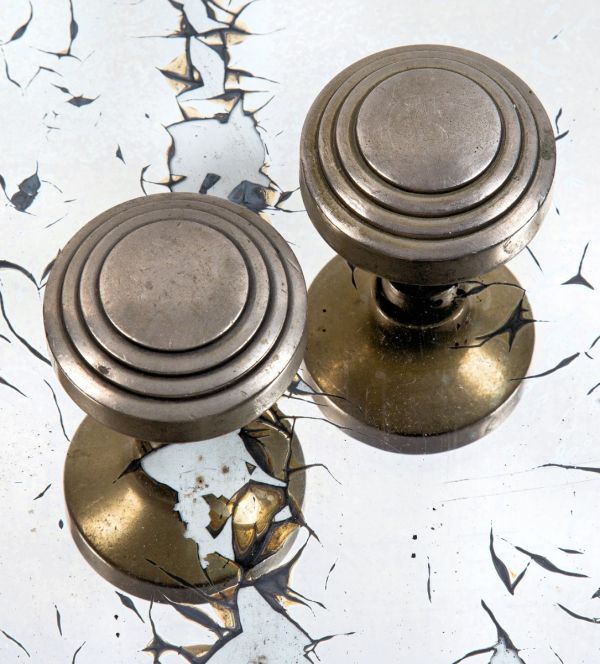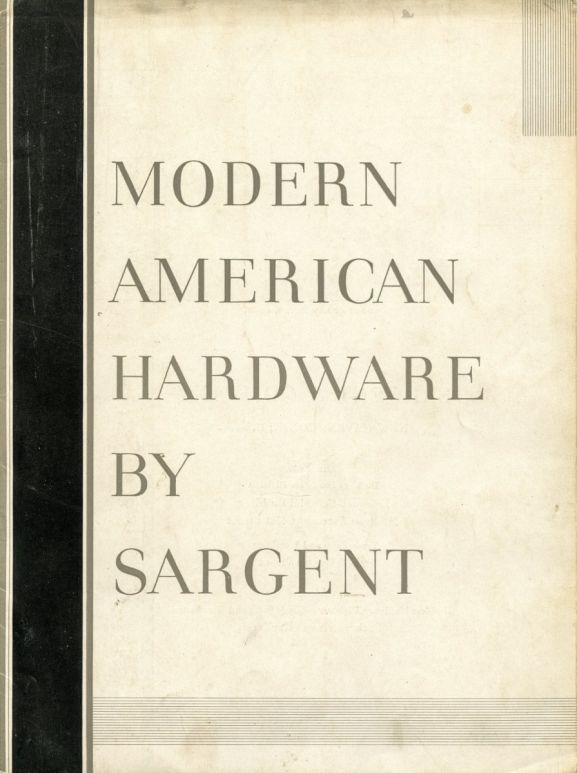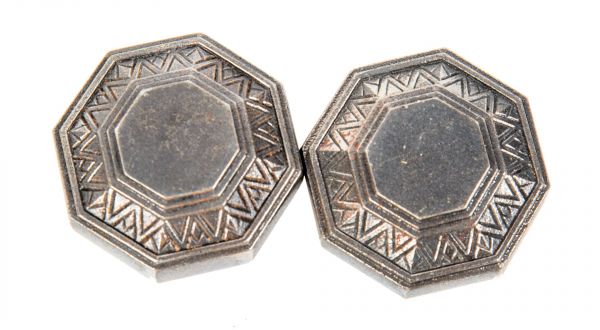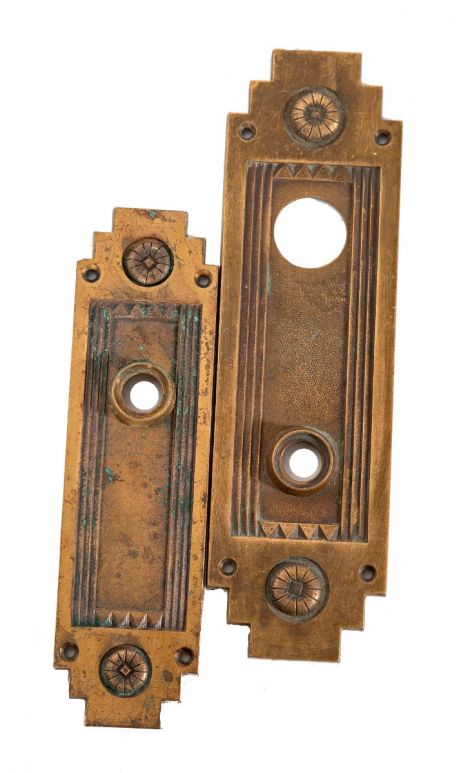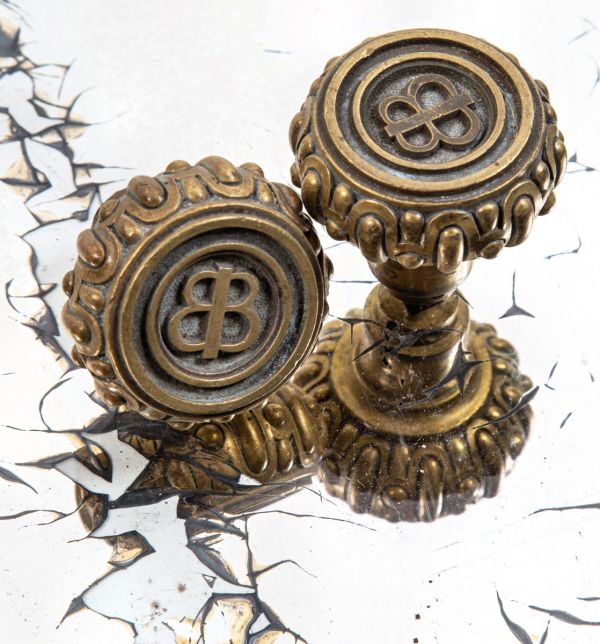super streamlined american art deco nickel-plated cast bronze custom-designed doorknobs from holabird and root's chicago board of trade building
the chicago board of trade building is a 44-story art deco skyscraper located in the chicago loop, standing at the foot of the lasalle street canyon. built in 1930 for the chicago board of trade (cbot), it has served as the primary trading venue of the cbot and later the cme group, formed in 2007 by the merger of the cbot and the chicago mercantile exchange. in 2012, the cme group sold the cbot building to a consortium of real estate investors, including glenstar properties llc and usaa real estate company.
the cbot has been located at the site since 1885. a building designed by william w. boyington stood at the location from 1885 to 1929, being the tallest building in chicago from its construction until its clock tower was removed in 1895. the boyington building became structurally unsound in the 1920s and was demolished in 1929, being replaced by the current building designed by holabird & root. the current building was itself chicago's tallest until 1955 when it was surpassed by the prudential building.
the current structure is known for its art deco architecture, including spacious streamlined marble interiors, mural of ceres and large-scale carved bedford limestone sculpture adorning the exterior. an three-story riveted aluminum art deco statue of ceres, goddess of agriculture tops the building.
in 1925, the chicago board of trade commissioned holabird & root to design the current building. the general contractors hegeman & harris built it for $11.3 million, although the reported twenty-year mortgage value was $12 million. clad in gray bedford limestone, topped with a copper pyramid roof, and standing on a site running 174 ft east–west on jackson boulevard and 240 ft north–south on lasalle street, the 605 ft tall art deco-styled building opened on june 9, 1930. it serves as the southern border for the skyscrapers hugging lasalle street and is taller than surrounding structures for several blocks. the chicago board of trade has operated continuously on its fourth floor since the 1930 opening, dedicating 19,000 square feet to what was then the world's largest trading floor. built in 1930 and first designated a chicago landmark on may 4, 1977, the building was listed as a national historic landmark on june 2, 1978.
the advent of steel frame structural systems allowed completely vertical construction; but as with many skyscrapers of the era, the exterior was designed with multiple setbacks at increasing heights, which served to allow additional light into the ever-deepening concrete valleys in urban cores. at night, the setbacks are upwardly lit by floodlights, further emphasizing the structure's vertical elements. the night illumination design was a common contemporary chicago architectural theme, seen also in the wrigley building, the jewelers building, the palmolive building, the lasalle-wacker building, and the tribune tower.
interior decoration includes polished surfaces throughout, the use of black and white marble, prominent vertical hallway trim, and an open three-story lobby which at the time of opening housed the world's largest light fixture. though one lasalle street had five more floors, the cbot building was the first in chicago to exceed a height of 600 ft. after surpassing the chicago temple building, it was the tallest in chicago until the daley center was completed in 1965. known for its work on the brooklyn bridge, the family-operated factory of john a. roebling supplied all of the cables used in the building's 23 otis elevators. beneath the main trading floor over 2,700 miles of telephone and telegraph wires were once hidden. no less than 150,000 miles (240,000 km) of wires (considered possibly the most direct long-distance wire from any building) once ran from the room. although the building was commissioned for the chicago board of trade, its first tenant was the quaker oats company, which moved in on may 1, 1930.
sculptural work by alvin meyer, the one-time head of holabird & root's sculpture department, is prominent on the building's façade, and represents the trading activities within. on each side of the 13 foot diameter clock facing lasalle street are hooded figures, a babylonian holding grain and a native american holding corn. similar figures are repeated at the uppermost corners of the central tower, just below the sloping roof. about 30 ft above street level, representations of bulls protrude directly from the limestone cladding on the building's north side and to a lesser degree on the east side, a reference to a bull market.
the central structure is toppd by a 6,500 pound, 31 ft tall aluminum statue by sculptor john h. storrs of the roman goddess of grain, ceres, holding a sheaf of wheat in the left hand and a bag of corn in the right hand, as a nod to the exchange's heritage as a commodities market. this statue was assembled from 40 pieces.
commissioned in 1930 but removed from the agricultural trading room in 1973 and stored until 1982, john w. norton's three-story mural of ceres shown bare-breasted in a field of grain underwent extensive restoration in spring grove, illinois by louis pomerantz before being displayed in the atrium of the 1980s addition.
according to the june 16, 1930 issue of time magazine, visitors carrying ripened wheat heads stared in curiosity at the six-story tall trading room directly above the lobby and behind the large windows below the clock facing lasalle street. at the center of the room, time reported on the items being traded in "pits" organized based on commodities type with pits names such as the corn pit, soybean pit or wheat pit. the individual pits are raised octagonal structures where open outcry trading occurs. steps up the outside of each octagon provide an amphitheater atmosphere, and enable a large number of traders to see each other and communicate during trading hours. with early versions dating back to 1870, this type of trading pit was patented in 1878.
You Might Also Like
WORDLWIDE SHIPPING
If required, please contact an Urban Remains sales associate.
NEW PRODUCTS DAILY
Check back daily as we are constantly adding new products.
PREMIUM SUPPORT
We're here to help answer any question. Contact us anytime!
SALES & PROMOTIONS
Join our newsletter to get the latest information

